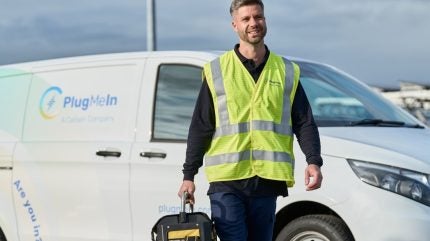
As many fleet operators eye the switch to an electrified fleet, it is also clear that they have questions surrounding the process of making such a radical change.
A leading subsidiary of the Calisen Group, Plug Me In, is working to support businesses to review their options when it comes to making the electrification switch. The company offers advice to businesses contemplating a switch to electric vehicles but are unsure about how or where to start the transition.
We spoke to Andrew Stead, commercial director, Plug Me In, to discuss how the company can assist fleets and highlight the additional benefits of making the EV switch.

Just Auto (JA): What is ‘Plug Me In’?
Andrew Stead: (AS): Plug Me In has been around for about two years. It’s an EV infrastructure focused business that was built on the back of relationships with hardware manufacturers. Its inception was installing large domestic charging units outside people’s homes. The reason it got brought into existence was because the wider organisation is a company called Calisen. Calisen is company that no one’s ever heard of, but they are in at least 50% of people’s households that have got a smart meter [measuring domestic electricity use]. They currently have about 12 million smart meters across the UK, which is important in terms sustainability and the transition to smarter energy. They own and operate all those smart meters on behalf of energy companies.

US Tariffs are shifting - will you react or anticipate?
Don’t let policy changes catch you off guard. Stay proactive with real-time data and expert analysis.
By GlobalDataCalisen’s view was that they wanted to bring adjacencies to market and electric vehicle charging is a really easy one to pursue. So, they’re already installing at people’s homes; they have a core skill set of people to do that. It was easy to build Plug Me In to deliver EV charging units on the side of people’s houses. We’re very agile, a small start-up business with that lovely umbrella over us; the huge corporate enables us to be a very agile, quick and also well-funded.
We are not only doing domestic installation work (putting chargers on the sides of people’s houses), but we’re also now installing on commercial premises, too. Calisen brings all the smart meters, but it is also important to note is that they own those assets.
How can Plug Me In support fleets?
AS: We own and operate all the charging infrastructure for the large organisations and we can make sure that they don’t have to worry about the financial impact of the assets. We can take on warranty issues, we can take on service costs, we can take the risk associated around new technology changes in charging, batteries etc – they just have to pay the monthly recurring rental for the equipment.
We give the client company the right to charge what they want; they might want to subsidise it, they might want to give it for free, they might make some money on it. It’s up to them. They have full control over that asset.
As a company we have been on this journey and seen mistakes made, because the industry wasn’t ready, the technology wasn’t ready or the vehicles weren’t available. As you go through that process, there’s a huge amount of absorbing of information and experience. It’s good to have that experience and to be able to bring it to bear when you talk to organisations about what they need to do, what they need to consider before investing in fleets of vehicles.
Everybody that I ever speak to wants to do the right thing and we all need to do whatever we can to reduce our emissions
Everybody that I ever speak to wants to do the right thing and we all need to do whatever we can to reduce our emissions. One of the most impactful things that we can do is changing companies’ fleets of vehicles, installing easy-to-access charging capabilities, enabling staff, visitors and the whole workforce to use EVs efficiently.
What are the benefits of Plug Me In?
AS: One of the key things at the front-end is – before you do anything – to actually get some good information, look at the telematics data, look at routes in detail. It’s about journeys you’re doing at the moment and therefore what vehicles are best suited to those patterns – and when and where vehicles need to be able to be charged.
There’s a huge misconception that in the EV world everyone should just go for fast charging. So many vehicles don’t take 22 kilowatt, it’s effectively wasted infrastructure and wasted power design.
It’s important – when thinking about that transition plan – to get the telematics data from the customers, to work closely with them in terms of establishing what’s the easiest and best thing to do today. There might be certain sites that have more power available or sites may be in a location where it’s more cost-effective for them in terms of usage.
There’s a huge misconception that in the EV world everyone should just go for fast charging.
It may be that when we speak to people we learn – for example – that there are constraints that they’ve got at their workplace site, which may mean they can’t put the infrastructure in at their premises. But they could still change the way that they utilise their vehicles by changing from a return to home fleet, to – instead – start charging vehicles at people’s properties and putting infrastructure in there.
We can help with that whole process – things like how you reimburse the drivers, optimising charging and looking at the monthly flow and cycle of all expenses. We can make sure that the charging infrastructure doesn’t become a stranded asset in terms of cost, because we can take the risk in terms of charging as a service rental.
We make sure that that infrastructure that is installed doesn’t become a legacy infrastructure that just dies a death if you lose a relationship with us as an installer. There are lots of companies out there that have closed networks that only speak to their software, and if you move away from their company, you’ve still got the infrastructure, but no way of controlling it. We always ensure whatever we instal is open and you have access.
We also always think about what you need in phase one, what you need in phase two, making sure that whatever we do today minimises disruption further down the road, avoiding high costs at the front-end. You can ensure that you can build on what we provide.
What advice would you give to fleet managers who are maybe still a little bit unsure about making the switch?
AS: This isn’t something we’re inventing right now; this is just normal. This isn’t something you should worry about as in the unknown; this is all possible. We’ve done it many, many, many times!
My words of wisdom would be just to consider ensuring that you partner with somebody that is going to be able to build a solution for you in a transition plan so you have a no-regret position. It’s super easy to do. We can manage this through energy balancing; we can manage it through where we deploy assets and we can manage it by minimising cost impacts on your drivers. Just make sure you can see those things before you go forward and you don’t get into a sort of regret position with legacy technology. Keep the risks down and stay with an open solution that is easy to deploy and that you can build on.



